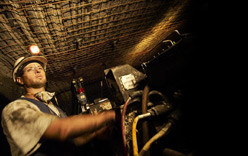LONGWALL BLOCK SIZE
As a general principle, within reason, the bigger the longwall block sizes the better. Factors which favour large blocks are:
- Relocating a longwall face from one block to another is a major logistical exercise involving high costs and during which there is no production (and hence no income) – the fewer moves required the better and the longer the blocks the fewer moves are required;
- There may be more initial development required to open a new longwall mine, or area of a mine, to create long blocks, but once this is done the main road development required is usually the same for each new block (unless additional airways are required to obtain satisfactory ventilation) regardless of block length. The longer the block, the lower the total development metres required per longwall tonne made available;
- When cutting, the slowest part of each cutting cycle (shear) is at the face ends, so the wider the face, the greater the amount of coal available to cut at the high rate;
- A large proportion of strata control problems, or work required to avoid such problems, occurs at the face ends in the gate roads. The wider the face the fewer the number of gate roads within the longwall area and the less the cost per tonne for gate road maintenance;
- Much of the gate road equipment is the same regardless of the face width, or at least the extra cost for gate road equipment for the extra width is relatively small. The wider the block the lower the capital cost per longwall tonne; and
- Beyond a certain block width, the chain pillar size required for stability is not affected. The wider the face, the less coal is sterilised in these pillars.
Factors which constrain longwall block sizes are:
- The size and shape of the coal lease, the location of existing workings (including those in under or overlying seams) and the desirability of avoiding geological structures can all constrain the size of longwall blocks;
- The wider a face the slower the face advance rate for a given cutting rate, which can have bad repercussions on strata control;
- Generally the wider the face the more difficult it becomes to control alignment and to steer;
- Long blocks require large conveyor installations, sometimes making an additional conveyor drive (usually a tripper drive) necessary;
- The larger the blocks (length and width), the more arduous the ventilation duty, whichever style of ventilation is used, particularly for lower seam heights. The long gate roads affect both longwall and development ventilation; driving more than 2 headings per panel will ease the ventilation duty, but this is seldom an economic option even if there is time available for this additional drivage;
- The higher the production rate, the greater the gas make which the ventilation and gas drainage system will have to accommodate;
- The larger the block size, the more arduous are the water supply, compressed air supply and possibly pumping duties because of the increased pipe friction losses which arise from increased pipe length (larger diameter or additional lines may be required to overcome this problem);
- The larger the block, the more likely it becomes that major equipment will have to be removed for repair/overhaul during the life of the block, instead of the more common practice of overhauls being carried out during relocations. With good planning, much of the equipment can be changed out reasonably easily at suitable locations during the block life, but in most cases a spare item needs to be available as it would not be good practice to stand the wall for long periods while overhauls are carried out. It is also necessary to be confident that strata control can be maintained during the inevitable standing time involved, even where spare equipment is available;
- The wider the block, the higher the initial capital cost involved. It is an option to increase block widths incrementally over several blocks to spread this cost, but certain items would have to be specified for the later higher duty when first purchased; and
- Power requirements for a wide face coupled with space available (with regard to seam height) can restrict possible face widths. AFC chain size is also a consideration here and in some mines heat produced can be restrictive.
Once a block size is chosen and the operating conditions are known as far as possible, then the specifications for the equipment can be drawn-up and design can commence.
It may, of course be necessary to revisit the plan several times as the size, cost and production capacity of equipment becomes known.
- Energy Citations Database (ECD) - Document #7160723 - one document reference which can lead into large database of technical information, including longwall information.
- http://ro.uow.edu.au/cgi/viewcontent.cgi?article=1067&context=coal - paper describing the use of a pre-driven recovery roadway at a longwall finish line

